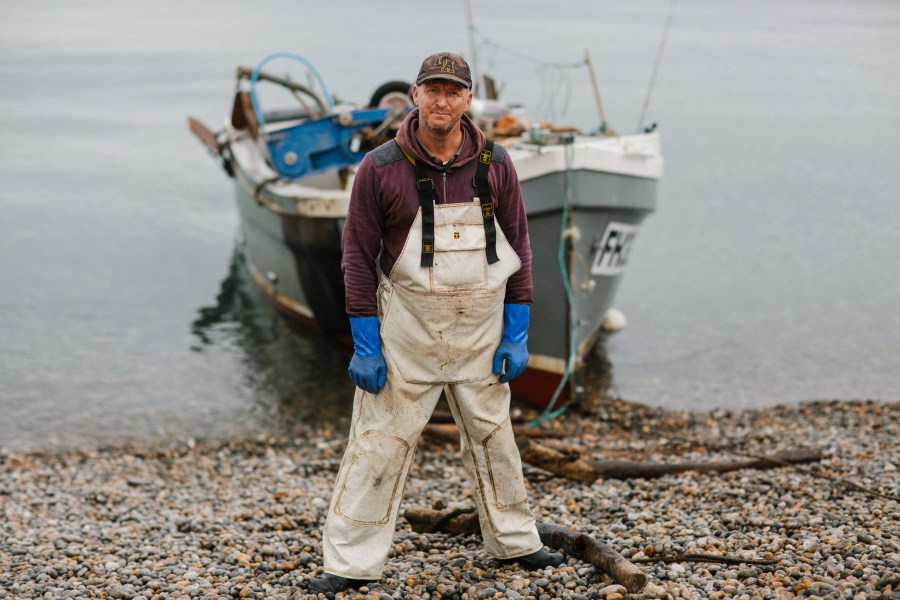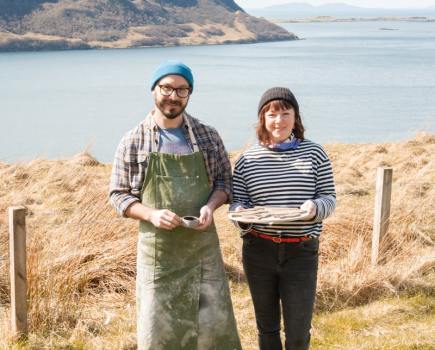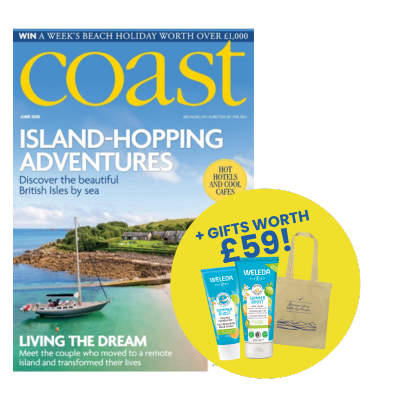They are a vital part of the heritage and future of Lyme Bay’s coastal communities. CHRISSY HARRIS meets the fishermen on a mission to make themselves heard – with a little help from a friend.
It’s 10am at Chris’s Cafe in Axmouth Harbour, Devon, and the bacon is sizzling. The first few fishermen are arriving to take their seats, ready to enjoy a hearty breakfast meeting.
Among the general chit chat and clinks of knives and forks comes an announcement with a distinctive American twang.
“Morning Dave – I have a tab set up, go order,” says Mandy Wolfe to fisherman Dave Hancock. “I love it here,” she says to me. “You can pick them off. It’s kinda like you’re corralling them.”
Mandy, it quickly becomes apparent, is awesome and in charge here. For the past five years or so she has been the mouthpiece (or megaphone, as she puts it) for the small-scale vessel fishermen that work in and out of Lyme Bay, a stretch of water that crosses the Devon-Dorset border.
Mandy first worked as fisheries liaison to Lyme Bay for the Blue Marine Foundation conservation charity before helping to set up the Lyme Bay Fisherman’s Community Interest Company (CIC) last year. This organisation, by fishermen, for fishermen, is being hailed as a blueprint for other coastal communities around the UK.
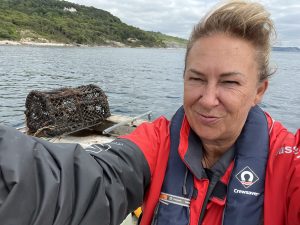
With Mandy at the helm, the collaborative company aims to give a voice to the little guys: the inshore fisherman, one-man, one-boat set-ups that fish across the four ports of Beer and Axmouth in Devon and Lyme Regis and West Bay in Dorset.
The aim is to listen, learn and find common ground between fishermen, government bodies, local officials and conservationists who want to encourage sustainable fishing methods in this specially designated marine reserve.
The CIC is also working on a series of projects designed to reinforce the connection between fishermen and the wider Lyme Bay community, through social media campaigns, news updates and information about where to eat and buy the latest catches. There are also plans to visit the region’s schools to give talks about the industry.
“It benefits everybody,” says Mandy, who spent years working for UK fishing companies after moving here from Orange County, California in 2003. “These fishermen want to safeguard their coastal communities and their industry that has been here for hundreds of years,” Mandy adds. “They’re becoming an extinct species, if you think about it.”
She’s suddenly interrupted by a yell on the street outside. “You’ve got a parking ticket, Mandy,” comes the cry (from local fisherman Gavin Ziemann).
“What?!” she says in mock horror. “Wait…No I haven’t – I’m parked over there! Quit picking on me!”
They all have a laugh at her expense – not that she minds at all. She’s spent years building up a rapport with these guys because that’s what it takes to get things done.
When she took on the role, Mandy found out where the local fishermen liked to hang out (Chris’s Cafe), marched down with her spreadsheet of names, boats, ports and started handing out teas and coffees.
“I think it was the fact that I’m very loud, I talk fast and have no filter made me seem a little bit odd and they just kind of allowed it,” says Mandy. “They thought – maybe she’ll go away. And then I didn’t. I just sat there, one coffee, two coffees, no one said anything to me – and then it started. They were like, do you know what, Mandy…I want to talk about this issue or that.
“People ask me how I do it. It’s easy. I just spend time with them.”
‘Bottom up’ is a phrase that crops up a few times throughout my morning here – and not in a rude way. There’s a feeling that the only way to protect and manage the future of Lyme Bay and its communities is to get everyone talking, from the fishermen who work these waters to the people in charge of regulating it all.
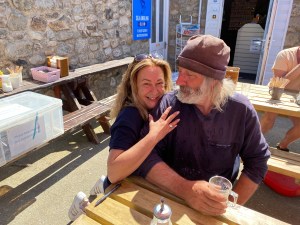
Since the CIC was formed, meetings between officials from the Marine Management Organisation (MMO) and fishermen have taken place at this very table in Chris’s Cafe.
Angus Walker has just sat down after ordering his regular latte. Angus is a fisherman (he hauled in 68 lobster pots yesterday), assistant chair of Axmouth’s fishermen’s association, Axmouth harbourmaster ‘and general dogsbody’. He is also 83, which is certainly worth a mention. Oh, and there’s a supersized breakfast named after him here at the cafe – three of everything.
“It’s got to work bottom up,” says Angus, who can trace his family’s fishing heritage back more than 600 years. “Mandy came into this to find out exactly what’s going on and that has spread to a lot of the enforcement agencies.
“We’ve seen a lot of the top tier of management of the MMO sat right here, where we are now. The CIC is still very young but there are an awful lot of people around the country hundreds of miles away who are watching us to see what happens.”
Small niggles about boxes to big gripes about outdated systems and new regulations are all on the Lyme Bay fishermen’s agenda, as is the need to safeguard this unique way of life.
One of the key tasks the CIC is taking on is an education outreach programme to try to get local children interested in being part of the industry’s future.
Gavin Ziemann is one of the ‘volunteers’ tasked with visiting up to 25 primary schools in the region with his kit and lobster pots as part of a pilot programme to teach kids about the life and work of a fishermen, as well as the amazing species in the local waters.
For Gavin (and brother Charlie, also a local fisherman), it’s a way of inspiring the next generation.
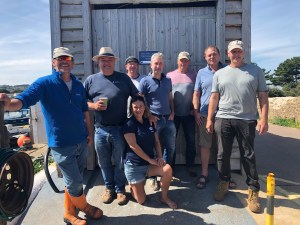
“It’s not like when we were young,” he says. “We were hanging around down on the beach when we were eight or nine years old, chatting to the local fishermen and going out with them for the day. That’s what got you started – every day was like an adventure. It wouldn’t be allowed these days.”
By now, the cafe has really filled up, with most of the outside tables taken by a heady mix of fishermen straight off the boats and tourists enjoying a ‘captain’s breakfast’ (no one has taken on ‘the Angus’ yet, however). There’s just something about this way of life that intrigues people.
“They’re like the last of the great hunters, aren’t they?” says Mandy in agreement. “These guys, the inshore fishermen, it’s the most dangerous peacetime occupation in the world,” she adds. “A lot of people are unsure about approaching them, but I want to show just how approachable they are, how much they love it when people come by and ask questions, the little kiddies asking them how you tell a male crab from a female crab.
“No matter how tired these guys are, that’s the bit they’ll remember from their day.
“Now, Angus, do you want another latte?”
Lyme Bay Fisherman’s CIC is supported by funding through the UK Fisheries and Seafood Scheme from Marine Management Organisation. See lbfcic.com
LYME BAY: A FLAGSHIP PROJECT
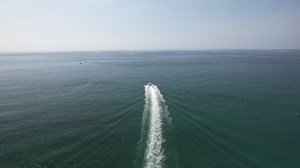
Lyme Bay is a Blue Marine Foundation flagship project, proving that sustainable fishing can co-exist with conservation. The reserve is one of the largest of its kind in the UK, with over 90 square nautical miles protected from dredging and trawling.
This helps to preserve the area’s rocky reefs and the largest colony of pink sea fans in the British Isles. Ocean sunfish, bottlenose dolphins, smooth hound sharks and light bulb sea squirts are just a few of the other species regularly spotted in the bay.
Blue Marine has created the Reserve Seafood brand to market the sustainable seafood of Lyme Bay.
Fishermen selling their catch through the brand follow a voluntary code of conduct to ensure fishing is within environmental limits. Sustainable fishing methods use only low-impact static gear, such as pots, static nets, rod and line or hand-diving.
EXPLORE LYME BAY
The region extends for 65km from Exmouth in Devon to Portland in Dorset, with everything in-between. You really do get the best of both counties here: beautiful scenery, great food, drink and loads to do.
EAT
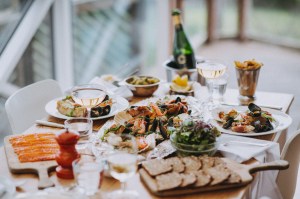
Enjoy fish and seafood caught by the Lyme Bay Fisherman’s CIC at The Oyster and Fish House, Lyme Regis. The menu changes twice a day, depending on what the fishermen have brought in. The restaurant is top chef Mark Hix’s solo venture.
Coast cafe and bar on the Esplanade, Seaton, also serves locally caught fish. The crab sandwiches here are top notch.
The regency charm is as good as the grub at Dukes, Sidmouth.
DRINK
You’ve just got to have a beer in Beer! Try the Anchor Inn, for a pint with a view. There’s a pub garden over the road, overlooking the beach.
Sample the local tipple in Lyme Regis. The courtyard of the Town Mill is home to the Lyme Regis Brewery’s Tap Room.
Brook Kitchen is a licensed art cafe and bar in Budleigh Salterton.
STAY

Relax and be pampered at the Alexandra, an independent, family-owned, 25-bedroom hotel in Lyme Regis. The many luxury options available in the treatment room include hot stones, aromatherapy, Indian head massage and more.
Take in the fabulous sea views at Lyme Cordial. This modern beach chalet overlooks Monmouth beach and the famous Cobb in Lyme Regis. Available through Toad Hall Cottages.
Oakdown is an award-winning holiday park just outside Sidmouth that’s been run by the same family for nearly 50 years. Choose from pitches, lodges or glamping in one of the shepherd’s huts, premier pods or barrel pods.
DO
Climb aboard: Pecorama in Beer is a much-loved (albeit it oddly named) attraction high on the clifftops at Beer. Kids and grown-ups can take great delight in riding on one of Britain’s finest 7.25-inch-gauge ride-on steam railways.
Trains are only part of the appeal here, however. The attraction’s gardens are real showstoppers. The Millennium Gardens have a celestial theme, with the sun, moon and rainbows reflected in the planting colour schemes. There is also a roof garden, scented walkways, a snake path, shell grotto and a secret garden, if you can find it. See pecorama.co.uk
Fossil-hunting: Looking for ammonites, belemnites and more along the Jurassic Coast gets addictive. The best places to look for Earth’s treasure are Monmouth and Charmouth beaches near Lyme Regis – great places for fossil finding firsts.
Better still, join in with one of the many organised fossil-hunting walks held around here throughout the year.
Follow the path: One of the best ways to see Lyme Bay is from the South West Coast Path. If you’re up for a challenge, the Seaton to Lyme Regis stretch is worth tackling. It’s steep and uneven and passes through the Undercliffs National Nature Reserve, a wild area of landslides and tumbled coastline. The views will be worth it, though.
Looking for more coastal interviews with local fishermen? Meet Dan the Fishman, the south west’s campaigner for the nation’s seafood here.

